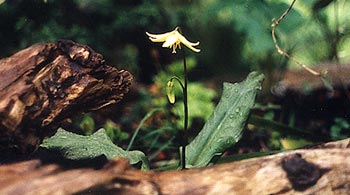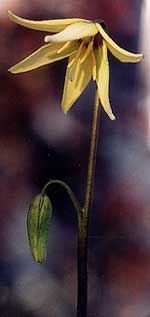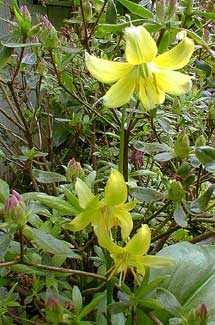 Dog's Tooth Lily
Dog's Tooth Lily
for a Woodland Garden Path
A North American woodland delight, Dog Tooth Lily has been blessed with a variety of regional names: Avalanche Lily, Fawn Lily, Glacier Lily, Trout Lily, Dog Tooth Violet. Due to the shape of the bulb, & because it's a cool name, Dogtooth or Dog's Tooth is the name that has spread furthest.
 We have a cultivar called 'Pagoda' which is a hybrid of two species, being less sensitive hence more adaptable to garden life than the sometimes delicate parent plants, yet losing none of the woodland wildflower delightfulness, matched only by trilliums which likewise grow from corms.
We have a cultivar called 'Pagoda' which is a hybrid of two species, being less sensitive hence more adaptable to garden life than the sometimes delicate parent plants, yet losing none of the woodland wildflower delightfulness, matched only by trilliums which likewise grow from corms.It unfolds its leaves from out of the ground as early as February, & continue getting larger right up through April, then blooms for mid-April to early May. Eventually the bulbs produce offsets & become a thickening clump of dogtooth lilies.
I had been warned that if Dog Tooth has any drawback it is the ephemeral nature of its blossom. If that's usually the case, however, it doesn't seem to be true of the Pagoda hybrid; the first two pictures on this page were taken of blooms over a week old in April 2002, & still going strong, with further buds waiting to open. So it blooms quite some while, unlike the truly ephemeral Bloodroot which is a sudden marvel in the garden, then the blooms are gone.
'Pagoda' begins to bloom around the cusp of April & lasts until May. The leaves also have beauty, falling halfway between tulip & hosta. Also like Bloodroot & Trillium, it is useless to try to make a bouquet out of them as they won't last if picked. In a temperate zone such as ours, they will naturalize in a shady garden quite easily, so are truly essential to a complete woodland look.
 The first year they bloom each bulb tends to have only one or two flowers, but the second year the stalks can raise to two & a half feet tall with increasing numbers of flowers.
The first year they bloom each bulb tends to have only one or two flowers, but the second year the stalks can raise to two & a half feet tall with increasing numbers of flowers.The third photo, from April 2003, is of a Dog Tooth I planted underneath a Korean Azalea. I didn't realize how much bigger it would get as it aged. What were smallish low-growing fat leaves the first or second year, become very big leaves by the second or third spring. I'd planted three of them under the azalea & had to lift all but one of them to transplant elsewhere. I now know to allow for them to have a great deal more room than I initially believed.
The blooms on the specimen in the third photo rise way up into the structure of the azalea. The azalea is only semi-evergreen & does not yet have its new leaves fully formed when the Dog Tooth first opens its blooms in the midst of the twigs. But its yellow flowers last long enough that the azalea's pink blooms are soon opening around the Dog Tooth's flower.
Dog Tooth Lily demands a lot of shade & persistent moisture. It can stand a little afternoon sun, or a little morning sun, but if it gets both, it will suffer. Our Pagodas are growing in two shady places, under the Korean azalea, & among ferns & trilliums & jack-in-the-pulpits around the birdbath in the shade of a large fountaining Franchet's cotoneaster.
They are perfect for under shading shrubs or at the foot of cameleas, or to add seasonal dashes of color to an otherwise bloomless array of ferns. I try to place them in locations where they won't leave gaps when they vanish once they are finished for the year, but where their reappearance in spring will be most impressive.